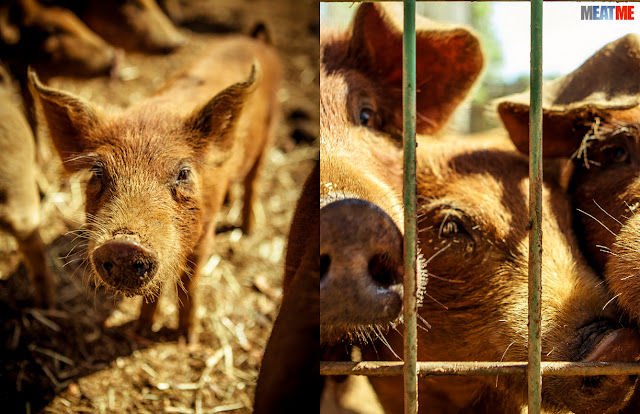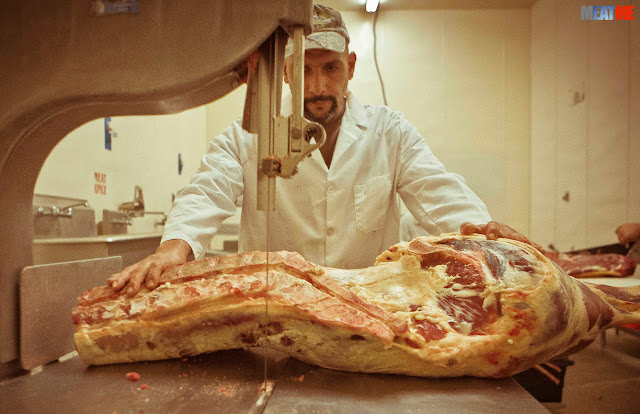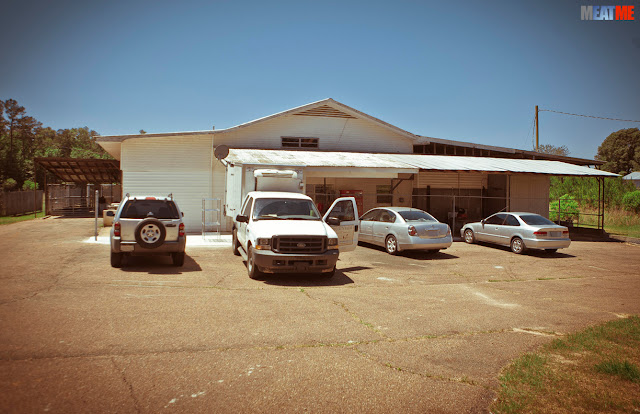It is very exciting to find out a products origin. We marvel in the history of the United States and how we came to be this great nation because of the sacrifice of so many people. There is one thing that we have always needed to conquer freedom’s challenges - and that is food. Thousands of years have been spent evolving the best practices for raising and processing food.
When I sit down and enjoy my delicious bacon, my mind wanders how an animal like the pig evolved into such a wonderful delight. It takes several variables to make it all come together so it can be the ideal flavor of perfection. Krystian Cook of Cook Pigs Ranch took it upon herself to breed, feed, and process the red wattle pig until it becomes mouth-watering perfection. With 2 young boys and a military husband who is often deployed, fighting for our freedom, she’ll find herself in 6 inches of mud at 5:30 in the morning pushing around 800 pounds of pig, feeding her obsession of “Pork Perfection”.
While in San Diego this last weekend I got the opportunity to drop by Cook Pigs Ranch and met Mike and Krystina Cook. They recently got into the business of producing the rare red wattle pig for consumption at local businesses. There is nothing I love more than a meaty rack of ribs or a nice juicy pork chop but when I find out that it is raised by a local farmer, a military wife and mother; each bite I take carries so much more appreciation and meaning. The endless hours that are put in to create each perfect bite become more of an “ode to this great nation” than a method of edible nutrition.
Small pig farms are rare due to the fact that they are so expensive to run. Most farmers find themselves driving hundreds of miles every week just to go to slaughter not to mention the time it takes to deliver each order to their customers. I got a chance to meet Krystina and find out just how crazy you have to be to take on such a challenge while carrying her family on her back:
MEAT ME: So where are we exactly?
Krystina Cook: Fallbrook, California at Cook Pigs Ranch.
We started everything here. I totally would have never thought I would be doing this… I’m from Los Angeles.
MEAT ME: Where bouts?
Krystina Cook: Calabasas. I grew up in old Calabasas so there was a horse community but we didn’t have wildlife. My husband is a huge hunter so when we moved here we decided we were going to have 2 pigs and use them for meat. Family friends also wanted fresh pork. My Dad let us know that it was illegal - you can’t just sell pork from your house; you need to go to the USDA and etc.
I started looking into it and got really obsessed with pigs. Not only did I love raising them but the idea of being at home with my kids and being able to do this on the side - it took off. I realized that we were in a niche that nobody else in San Diego was doing it. Lefty produces North of Los Angeles but there is no one else.
MEAT ME: So who are you currently supplying to?
Krystina Cook: Right now we have a few contracts we haven’t even supplied yet because we are still in the beginning part of the process. We are going to supply Delicious Restaurant in Rancho Santa Fe and Quero Restaurant in San Diego. Next week we are giving out 1,300 pounds of pork samples and we have a bunch of meetings so we’ll see about that. There is another place called Sunrise Ranch here in San Diego. They have a farmers market and they do our type of set up but they market the pork as their own. We plan on selling our processed pork to them. We also have a few prospects in Los Angeles that we plan on selling to once we get into full production.
MEAT ME: So is your goal to supply hogs to restaurants locally?
Krystina Cook: Yes. There are several high-end chain restaurants in Palm Desert that plan on buying from us. Temecula has 3 different wineries that want to buy from us. It’s just a long list that we are trying to keep up to date as we are expanding.
MEAT ME: I am guessing that your ranch has to be USDA inspected?
Krystina Cook: No because our process does not fall under USDA. We bring them to a USDA facility. We do exactly what Lefty (of ReRide Ranch) does.
MEAT ME: What does he do?
Krystina Cook: He goes all the way up to Modesto, California to have his hogs processed. I go to Santa Paula. There is a brand new USDA facility there which is a very small family run business. We already have a contract with them in place. I haul the pigs to him every week. He does complete custom orders, whatever I want which is typically skin on. I like to sell the whole hog. I get it delivered by a company that has a licensed refrigerated truck and it goes directly to the chefs. The concern with delivering using my truck is that the mileage would add up. It’s a long drive from here.
MEAT ME: So you’re going to slaughter once a week?
Krystina Cook: Yes. Eventually it will be a consistent once a week.
MEAT ME: So once a pig is born, what is the typical life cycle?
Krystina Cook: We do a really slow feed program, which is 14 months. We don’t feed them anything conventional. We feed them with avocados, beer mash, left over fruits and vegetables from left over produce. I go to different CSA’s (Community Supported Agriculture). They’ll call me up and let me know they have a truck load of lettuce. I go and pick it up and give it to the pigs. Their diet is very organic. It’s macrobiotic in that sense it comes from trees that are producing fruit and macadamia nuts locally.
When I developed the business model or method I asked myself, “Why would anyone want to buy a pig from me when they can go to the supermarket and buy from there?” What’s the difference? One of the big differences is commodity pigs are grain fed. It’s like McDonald’s. I started researching all of the ways you can raise pork and I found Ibérico pigs in Spain that are milk and whey fed and finished with acorns. I thought that would be really cool. It’s actually really hard to just give them milk cause you wash out the flavor and wash out the meat. They have to have a really specific way of doing it.
In Hawaii, the University of Hawaii funded a program for all the local restaurants and farmers to feed their pigs with really green produce. Due to limited space, the hogs were housed indoors, but because of what they were fed there was little to no smell of excrement. The healthy diet reduced their levels of ammonia and methane. They were so delicious they were selling them for $10 per pound. Not to mention their feed cost was almost nothing.
So that’s where I got the macrobiotic diet for wild pigs, only fattier than a wild pig so you get a great fat cap and that’s where we started our business model. It has just taken off. We are constantly in talks with farmers trying to get great produce in. Sprouts will sometimes give us their produce.
MEAT ME: What would you say is the average cost per pig?
Krystina Cook: That depends. If we are short on food then I have to go out and buy hay and the nuts. We do grow macadamia nuts here but not enough to feed the pigs. I don’t know because it is such a variable cost.
MEAT ME: A lot of farmers that I speak to that are producing to supply locally aren’t raking in the dough. Most of them are barley breaking even. Is that where you find yourself?
Krystina Cook: Right now. Yes. My entire family is invested in this now. Now I don’t think that will be the case in the next 3 years. I think we’ll be successful once we have consistent contracts and stick with our business model and local leftover produce.
If you look on line, some of the most successful businesses are in Henderson, Las Vegas because they are getting the leftovers from casinos. Making unbelievable money, but they do indoor commercial.
Mike Cook: It’s a pretty gross operation.
Krystina Cook: Right now we’re just breaking even. If Mike wasn’t working full time and didn’t have a career then we couldn’t do this. Pigs become exactly what they eat. Let me show you our pigs.
Mike Cook: It’s funny they think our fat dog is their leader. Sometimes he’ll go into the pen and they’ll clean him; his ears and everything else.
MEAT ME: Wow! Your pigs are very photogenic, have they modeled before?
Krystina Cook: (Laughs) I take a lot of pictures.
MEAT ME: So what types of pigs are these?
Krystina Cook: They are red wattles which is a heritage breed pig. They are almost extinct. You see those huge wattles hanging off of their face? Most of ours have wattles and some of them are mixed. That’s our big difference here most farmers don’t do wattles in Southern California. The closest person that does red wattles is on the border of Oregon. Their meat is like a rib eye. Its dark red meat and the fat cap is about 3 inches thick. They are definitely a fat pig. They are not a lean pig so if you want a lean pig they are not your friend. It’s delicious and perfectly marbled but they do need to be pastured. These are not commercial pigs.
MEAT ME: These 3 pens are…..?
Krystina Cook: This is our maternity ward. In fact we have a fourth pen that connects. You can see where all the water runs down on our property. We lost about 20 piglets this winter, maybe more, from the mud. They have to stay at 90 degrees when they are born and if they get cold or stuck in the mud, they die. I came out here one morning it looked like a massacre. So we decided to move them to the concrete. We keep it hosed down and really hygienic. We have a better mortality rate. The middle pig “Unknown” is nursing because all of her babies died and that’s the only one left. Wilma is due on Friday.
Over here is our breeding stock. Right now we have one boar. We have bought 2 more. So each boar will have its’ own space and we’ll rotate the females in and out. This is Dorthy. She’s also due the week after next.
MEAT ME: How long is the birthing cycle on a pig?
Krystina Cook: 3 months, 3 weeks, and 3 days. (made me think of the 3 little pigs) Really fast production.
MEAT ME: What is the average littler?
Krystina Cook: Ours with these crosses are pretty big; usually 12-14. They have a quick turn around time. Three days after they stop nursing they can get pregnant. We don’t turn them that quickly. We give them time to let their milk dry up and move them away from the babies.
We have already purchased 20 more breeding stock that a farmer is holding for us until we move. We’ll have about 30 sows and 3 boars. If they only produce 10 a litter, we are talking about 300 or so pigs per year.
We have a mix of pure red wattles and duroc crosses but most of them are original red wattles. Once we move, all of our animals will be pastured on half to one acre of land each. Each pen, a toddler pen, a butcher pen, and the sow pen will each have a half to one acre.
MEAT ME: What is a typical day for you?
Krystina Cook: Wake up at 5:30-6 every morning because my boys HATE to sleep! Get them breakfast and out to feed everyone by 730ish. We spend 2 hours in the mud getting dirty cleaning pens and feeding. Then I do "normal" mom stuff.. Play dates, errands, swimming etc. During that time we also pick up feed and I do marketing and business calls for the ranch. We get home, unload the feed and spend another 1-2 hours feeding and cleaning and of course getting dirty as hell! Then it's dinner time, serious bath time, bed time, and if Mike is home, whiskey and beer time!
MEAT ME: How often does Mike get deployed?
Krystina Cook: Mike and I have been through 3 deployments prior to having kids and marriage. He was on shore duty (un-deployable) for 3 years and has seen both boys born and growing up to be the crazies that they are! He will be gone all the time during the next 4-5 years. He will be deployed in August for 9-10 months then will be home for 10 months and then gone again. When Mike is home, honestly, everything is better, like more complete, but not easier. I never view things as being hard or easy it's just life and it always will have its ups and downs. I do feel for my boys. They are at the age where they get it and are affected by his absence.
MEAT ME: What are some of the challenges you face as a military wife when Mike is deployed?
Krystina Cook: Changing out plumbing, moving pigs around by myself, having two sick kids and having pigs in labor, picking up feed when my kids are so spent from driving around all day, maintaining the yard. Pretty much everything is challenging without him. But I stay up late and get up early to get it all done.
MEAT ME: What advise would you have for other women out there that are thinking about starting their own hog farm?
Krystina Cook: Yeah! Don't do it! You know, when we started this, I met a woman from Anza that does hogs with her hubs, and she said “I hope you have good insurance because you will need to be admitted to a mental hospital!” I didn't get it then but I do now! It's insane the amount of work I (as a farmer) put in everyday along with maintaining my kids’ sanity and happiness. But honestly, I love it. I mean like passionately am obsessed with it. Sort of like an oil painting I guess (Krystina is a Fine Arts major and as a Masters in Art Therapy/MFT). What I mean by that is it’s all a masterpiece in work and it's a slow progress but the more you look at things and manipulate it, the more beautiful it becomes. I guess my form of art now is the pigs. They make me happy and I love seeing the finished product which is as beautiful as the live product!
My only advice to anyone is to follow your dreams. Follow them with a vengeance because no one can define your own happiness. Only you can. Life is short so make shit happen. Don’t feel bad for yourself or live in sorrow because then you’re just stagnant and life moves; so go with it. That's what I do everyday and I'm so lucky because I found a partner in my life who lets me do that and does the same. I guess there is no advice for just female or mom farmers. It's just to do what makes you whole and happy and this is the lifestyle that does that for me. It's my own therapy.
So who’s up for the challenge? I am. I can’t imagine what kind of person it takes to be able to do all of that - Obviously a very powerful and amazing woman with a huge amount of guts and passion. There are only 2 small local farms in Southern California (that I know of) so it sounds like there’s a lot of opportunity and innovation to be had by the Cook Pigs Ranch. I wish them the best of luck and have the greatest respect for what Krystina and Mike are accomplishing.
You can check out Cook Pigs Ranch website at: http://www.cookpigs.com/
I would like to thank them for their time and welcoming me on to their ranch. I have so much respect for the people who fight to protect this great nation, so with that THANK YOU MIKE and Godspeed!
Written and photographed by Sean Rice, Edited by Aaron Black (Meat Inc.)
Respect the MEAT!
Sean Rice
Aka MEAT ME



















































